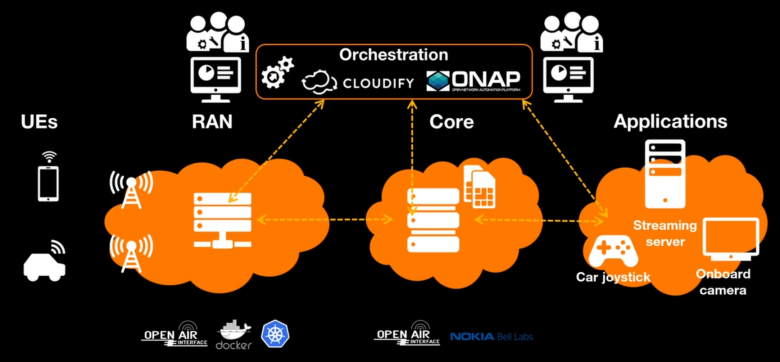During the past few years, Telecommunications industry was characterized by continuous evolution and integration of innovative concepts. Software Defined Networking (SDN), Network Functions Virtualization (NFV), and Cloud technologies are changing the way mobile networks are designed, deployed, and operated [1]. SDN improves network architecture by bringing dynamic scalability, easier management, and reducing the required manual effort. In fact, traditional networks rely on expensive components characterized by high maintenance costs. SDN adds an abstraction layer between network resources (hardware) and network management operations. This software-based paradigm eases network management and control operations, and reduces operational costs. As for NFV, it allows creating and provisioning networks using software functions; thus, decoupling the network functions from their underlying hardware. Traditional networks use dedicated hardware solutions coupled with proprietary software. These costly solutions are now replaced with software network functions (open source or proprietary) running on shared hardware resources.
Before this technology revolution, we were used to have physical network functions that consist of proprietary software solutions tightly coupled to the underlying hardware. Data plane traffic, such as mobile users’ traffic, and control plane, that includes network signaling traffic, were also coupled, in the sense that both planes are handled by the same network function, and are using the same network resources. SDN enables the separation of control plane of a network from the data plane that forwards network traffic, with the goal of creating a fully programmable network that can be managed in a logically centralized architecture. NFV enables automated deployment of software-based network functions over dedicated or shared infrastructure resources, facilitating the automation of control and supervision operations, including deployment and runtime monitoring.
In this context, we make use of these opportunities to showcase how open source software and tools are enabling innovation in 5G networks and beyond. In fact, new opportunities brought-up by network virtualization are accelerated by the existence of dynamic open source communities, such as Open Air Interface Software Alliance (OSA), and Linux Foundation that hosts open source Telecom related projects. This dynamic ecosystem brings the advantages of Information Technologies (IT) industry into Telecoms. Open source software allows not only creating end-to-end 3GPP compliant 4G/5G mobile networks over commodity hardware, but also modifying the created networks to implement, test, and showcase our innovative ideas. These experimentations were not possible a few years ago when we completely relied on commercial solutions that consist of proprietary software tightly coupled to the underlying hardware.
In the following, we present a Proof of Concept (PoC) of an end-to-end open source mobile network, which includes a Radio Access Network (RAN) and Core network running on top of commodity hardware, as well as an orchestration entity to operate the network [2]. We also demonstrate how open source software accelerates innovation by modifying the source code of the base station’s scheduler to prioritize time-critical traffic on the downlink [3]. This innovation, that is the result of a PhD thesis done at Orange Labs, is now implemented and demonstrated over an experimental mobile network.
Network Orchestration and Open Source Components
In our PoC, we use an open source network orchestrator to deploy the mobile network. The demonstration setup is shown in the following figure.

Figure 1. Demonstration setup
Our goal is to use Open Network Automation Platform (ONAP) [4] orchestrator to perform initial deployment and reconfiguration of Virtual Network Functions (VNFs) as Cloud-native functions in containers. We used an open source solution called Cloudify Community Edition [5] that is aligned with ONAP in terms of properties, and that allows for cloud native support. The demonstration shows how an end-to-end network is automatically deployed on Cloud infrastructure using an open source orchestration tool. The orchestrator also allows upgrading the network at runtime without service disruption such as automatically replacing running VNFs by new ones supporting additional features.
Orange is actively engaged in open source communities. We are active contributors to ONAP, an open source network orchestrator that automates Cloud-Native Functions (CNF) deployment and reconfiguration at runtime. Orange is also strategic member of Open Air Interface (OAI) Software Alliance (OSA) [6] that provides 3GPP-compliant open source software implementation of User Equipment (UE), RAN, and Core network. Our RAN is built using OAI source code. For the core network, we used both OAI Evolved Packet Core (EPC) and a software-based core network (LTEBox) provided by Nokia Bell Labs and designed for research purposes.
Traffic Prioritization
Inspired by the results of a Ph.D. thesis done at Orange Labs [7], we have implemented a flow prioritization mechanism at the scheduler of the base station. In fact, this kind of Proof of Concept is made easier thanks to the availability of open source code for the RAN and Core network. The source code of the eNodeB is installed and running on commodity hardware: Intel Next Unit of Computing (NUC) characterized by 4 vCPUs and 8 GB RAM.
To showcase our innovation, we consider a scenario where two users are connected to the network: a commercial smartphone and a connected car (Raspberry Pi car equipped with 4G dongle). Both users have traffic on the downlink: the smartphone is streaming a video from a video server, while the connected car is controlled remotely through the network i.e., the car control signal reaches the car via the dongle over the radio interface, after going through the Core network and the RAN.
We have chosen the connected car as an example that illustrates time-critical traffic on the downlink. In fact, regardless of the number of users attached to the network and the congestion that might occur, the critical traffic should always be prioritized over the remaining traffic, such as video streaming traffic. The connected smartphone and Raspberry Pi car are illustrated in the figure below.

Figure 2. Smartphone and raspberry Pi car connected to the network
When our flow prioritization mechanism is active, an accurate driving is performed; otherwise, the accuracy between car control actions and the real path of the car is compromised [8].
Takeaways
Our lab demonstration is also performed with over-the-air transmission i.e., with software radio peripheral connected to a power amplifier and antenna loaned by our partner b<>com [9]. Transmissions are made on LTE Band 38 (Time Division Duplex, 2.6 GHz frequency, and 5 MHz bandwidth).
This demonstration was presented at Mobile World Congress MWC’19 in Barcelona, and Orange Research Exhibition (SDLR’19). It proves that we are able to automatically deploy and run open source mobile networks using open source orchestrators. It also shows how we can demonstrate and implement our innovations on open source experimental platforms.
Our demonstration highlights how Orange is preparing the evolution of today’s mobile networks towards more cloud-native, dynamic and flexible networks. Our engagement in open source communities is a mean to accelerate innovation and the standardization of future mobile networks.
Perspectives
Orange is also actively engaged in Open Radio Access Network (O-RAN) Alliance [10] that is jointly-lead with major Telecom operators of the world to promote RAN intelligence and interfaces openness and interoperability. Demonstrations and PoCs using open source code are a manner to push our innovations and to accelerate standardization efforts.
Our future plans include network upgrade to full Stand-Alone (SA) 5G network as soon as OAI 5G New Radio (NR) source code is released along with open source 5G Core network (5GC). 5G network deployment and supervision will be fully automated using ONAP orchestrator and Cloud-native VNFs. The platform will be enriched by innovative 5G use-cases.
More:
https://hellofuture.orange.com/en/what-if-5g-experimentation-were-open-source/
https://hellofuture.orange.com/en/marion-duprez-driving-open-integrative-5g-research/
References:
[1] Y. Li and M. Chen, “Software-Defined Network Function Virtualization: A Survey,” in IEEE Access, vol. 3, pp. 2542–2553, December 2015.
[2] M. Yassin, et al., “5G End-to-End Open Source Network: Architecture and Use-Cases,” in IEEE European Conf. Networks Commun. (EUCNC), Valencia, 2019.
[3] “What if 5G Experimentations Were Open Source?” [Online]. Available: https://hellofuture.orange.com/en/what-if-5g-experimentation-were-open-source/
[4] Open Network Automation Platform [Online]. Available: https://www.onap.org/
[5] Cloudify Orchestrator Community Edition [Online]. Available: https://github.com/cloudify-cosmo
[6] Open Air Interface Software Alliance (OSA) [Online]. Available: https://www.openairinterface.org/
[7] W. Diego, I. Hamchaoui, and X. Lagrange, “Cross-Layer Design and Performance Evaluation for IP-Centric QoS Model in LTE-EPC Networks,” in IFIP Wireless and Mobile Networking Conf., Munich, 2015.
[8] M. Yassin, W. Diego, and S. Imadali, “Demo Abstract: 5G End-to-End Open Source Network with Traffic Prioritization Mechanism,” in IEEE Conf. Computer Commun. Workshops (IEEE INFOCOM), Paris, 2019.
[9] End-to-End Open Source Mobile Network Demonstration [Online]. Available: https://www.dailymotion.com/video/x74531o
[10] Open Radio Access Network (O-RAN) Alliance, (2019), “O-RAN Alliance Overview,” [Online]. Available: https://www.o-ran.org/











